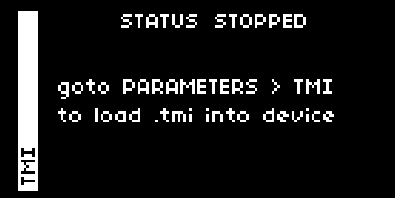
| project name: | tmi |
| project url: | https://github.com/schollz/tmi |
| author: | infinitedigits |
| description: | library for sequencing midi with text |
| discussion url: | https://llllllll.co/t/tmi/40818 |
| tags: | utility midi |
tmi
textual music instructions / tiny midi interface / too much information
https://vimeo.com/503866942
tmi is a norns library for composing and sequencing devices with text, ported to norns from a version i previously wrote. its basically a norns tracker, but unlike other norns trackers with wonderful visuals and features (e.g. yggdrasil, orca), tmi has few features and basically no visual interface. however, the one feature that tmi does have is that tmi can be used within any other norns script so with a few lines of code+text you can sequence multiple external devices (notes and ccs) from your favorite norns script.
tmi music tracks are written in text files (more on that below). when tmi is added to a script, these files can be loaded via the PARAMETERS > TMI screen in the parameters menu. once loaded, any changes to files are hot-loaded so you could do live-coding (if you have a computer handy).
this script finalizes a trilogy of norns scripts i’ve been writing that can be imported into other norns scripts. my goals was to take a existing sample-based script be able to also…
- …have command-mapping to single buttons (via middy)
- …be compatible with a grid-based drum machine (via kolor)
- …be able to do midi sequencing (via tmi)
the importable scripts above work in a multitude of scripts (barcode, oooooo, cranes, otis, to name a few) but might not work with all (especially if the host script already uses midi or something).
Requirements
- norns
- external midi device
Documentation
Install
first install in maiden with
;install https://github.com/schollz/tmi
then edit an existing script. in the existing script add these lines of code somewhere (preferable near the top) of the script:
if util.file_exists(_path.code.."tmi") then
tmi=include("tmi/lib/tmi")
m=tmi:new()
end
if you want tmi to play a certain file on a certain instrument right away, you can add these two lines:
-- change "op-1" to the instrument your using
m:load("op-1","/home/we/dust/data/tmi/somefile",1)
m:toggle_play()
now open the script and goto the parameters menu: PARAMETERS > TMI. make sure you have your midi device plugged in before you start, otherwise TMI menu will not be available. now you can load tmi files into any connected midi instrument (up to 4 tracks per instrument).
Making tmi files
tmi works with text files with textual musical notation - either notes, chords, rests, or sustains. by default these files are found in the ~/data/dust/tmi directory. you need to make these files yourself using maiden or another text editor.
rules for these files:
- one line is one measure, and is subdivided according to how many things are in it. example: “
C . . .” plays a C-major chord on beat 1 and rests for 3 beats - chords start with an uppercase letter, inversions allowed with “
/” and octaves allowed with “;”. examples: “Cmin”, “F#min/A;4”, or “Db;5”) - notes start with a lower case letter, with optional octave number, separated by commas. examples: “
e5”, or “f4,a,c” - the “
-” character sustains the last entry - the “
*” character re-plays the last entry - the “
.” character is a rest - multiple sequences can be in one file with each below a line specifying “
pattern X” where you fill in “X” - if multiple sequences are in one file, chain them with “
chain X Y” - comments are specified by “
#” - pairs of numbers are interpreted as cc number and cc value respectively, example: “
24,99”
by default tmi uses a meter of 4, but this can be changed at startup using m = tmi:new{meter=X}.
examples of tmi files
the following are valid tmi files.
this one plays four chords:
# a four chord song
C
G/B
Am/C
F/C
this one alternates between holding out a C-major7 chord and an arpeggio:
# switch between playing a chord for two measures
# and an arpeggio of the chord
chain a b
pattern a
Cmaj7
-
pattern b
c4 e g b c e g b
c6 b g e c b g e
modulate two ccs (74 and 24) periodically:
74,100,24,40 74,99,24,40 74,99,24,42 74,99,24,45
74,98,24,48 74,97,24,53 74,96,24,58 74,95,24,64
74,94,24,69 74,92,24,75 74,91,24,81 74,89,24,86
74,87,24,91 74,85,24,94 74,83,24,97 74,81,24,99
this last example is actually generated from a lua script. though you can certainly type out the numbers you want, you can also generate your own cc lfo patterns on any number of ccs, just open ~/dust/code/tmi/lib/cc_lfo.lua and edit it and then run:
> lua ~/dust/code/tmi/lib/cc_lfo.lua > ~/dust/data/tmi/your_ccs